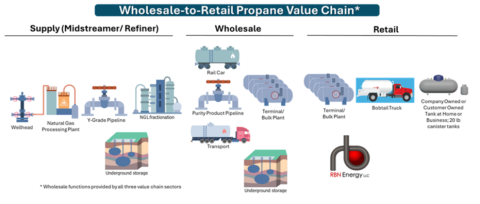The U.S. propane market may appear seamless at times, but a lot is happening just below the surface to determine consumer pricing. Key factors include the high seasonality of demand, supply contracts that must account for the seasonality of product delivery and the price, and the cost of transportation from terminals to bulk plants to end users. In today’s RBN blog, we will review the final delivery steps, the impact of transportation costs, and how contracts are priced.
This is the fifth and final blog in our series about domestic U.S. propane markets. In Part 1, we outlined the journey of propane from wellhead to burner tip and the various segments of the domestic propane market, including industrial, petrochemical, commercial, residential and agricultural demand. In Part 2, we detailed the role of wholesalers (middle section in Figure 1 below), whose primary function is to aggregate supplies, operate logistics networks, trade propane and integrate midstream operations. (Recently, in Should I Stay Or Should I Go?, we addressed some issues facing wholesalers today.) In Part 3, we introduced how retailers (right section) get their product and then sell and deliver it to the final customer. In Part 4, we covered the seasonal nature of propane demand and how it impacts storage levels and buying patterns.
Figure 1. Wholesale-to-Retail Propane Value Chain. Source: RBN
Join Backstage Pass to Read Full Article








